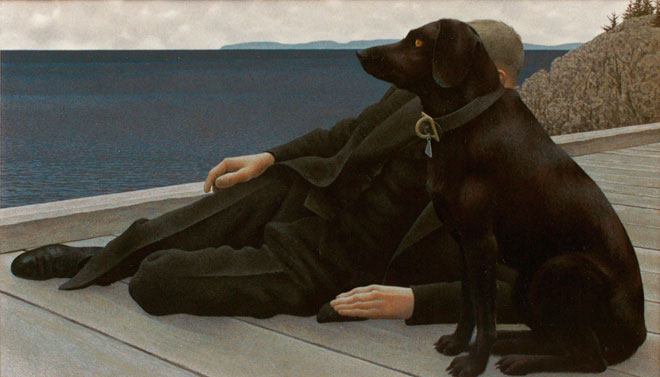The new show at the Art Gallery of Ontario is called “Alex Colville”. Other shows have had epithets attached.
- Frida Kahlo and Diego Rivera was titled “Frida & Diego: Passion, Politics and Painting”
- Francis Bacon and Henry Moore was titled “Francis Bacon Henry Moore Terror and Beauty”
- The early Renaissance show too had a descriptive phrase attached: “Revealing the Early Renaissance: Stories and Secrets in Florentine Art”
Not so for Alex Colville, who is presented here without qualifying epithets. That’s a good thing, I believe, even if I seem unable to resist the urge to supply one myself. Yes, I took the liberty of adding my own in my headline above, a couple of nouns to further mystify your experience. But I promise to explain myself, and to suggest that I’m on the same page with the AGO.
You add adjectives at your peril, I suppose. Going through the show, curated by Andrew Hunter (the AGO’s curator of Canadian art), I felt very much in touch with the inscrutability of this art. I was struck by a certain Pinteresque quality to some of these paintings. Previously? I’d merely thought “I don’t get Colville”, but now I recognize something about his ambiguities, his openness (in the sense of Eco’s “open work”), and refusal to declare himself or make our experience easy by signalling how we should respond. No, he keeps us poised on the edge, sometimes wondering what we’re looking at. Now of course this is hardly unique in modern art.
My respect for this artist has gone up 100 fold, even as I am –again—impressed by the job the AGO does in selecting shows & presenting them. But what’s especially intriguing about this one is how we’re looking at a Canadian artist treated with the love & gravitas usually accorded the great masters. It’s a marvelous thing to experience.
As my wife and I discussed while walking through, this is especially powerful on the heels of the Bacon & Moore show from earlier this year. We are again confronted with an artist traumatized by war, changed forever by what he’d seen. It’s a brilliant stroke if AGO deliberately put Colville on to follow Bacon & Moore, and if it’s inadvertent then it’s simply our good fortune.
Here we are again confronting human bodies, sometimes lovingly presented, sometimes from afar and as if the viewer were alienated or traumatized. The bodies are sometimes alive, sometimes: not.

Alex Colville, Bodies in a grave, Belsen, 1946. Oil on canvas 76.3 x 101.6 cm. Beaverbrook Collection of War Art, Canadian War Museum (19710261-2033) © A.C. Fine Art Inc
The small part of the show that takes you through Colville’s experience of Bergen-Belsen stays with you, and for me at least, forever changes how I see those chilly Canadian icons. I now understand them in a whole different way. Colville was born in 1920, which means he was, if anything, at a far more impressionable age during the war than Bacon (born in 1909 and thirty years old during the London blitz) or Moore (born in 1898 was already in his 40s when the war started).
The exhibition showcases several ambiguous images that can be taken as menacing images. That’s the thing: that they’re ambiguous. I am hesitant, even if the possibility of danger is impossible to avoid, especially in images of dead bodies or people holding handguns.
But I want to balance this with something that, to my knowledge, hasn’t been remarked upon in Colville’s works. It’s the most obvious thing, really, even if it’s impenetrable in its equivocality. Colville paints or draws images of his wife year after year, and without romanticizing. Let me be clear. When I say “without romanticizing” I don’t mean he doesn’t love her. Oh no, I mean, he sees her exactly as she is, but then again he saw—and portrayed—himself with just as much honesty.
In one of the videos that the exhibit includes, Colville alludes to the love he had for his wife, but very obliquely. This is not a man who made bold statements, neither in his romantic life nor in his paintings.
Or to put it differently: he and Robin were married in 1942, during the war. Robin died Dec 29th 2012. Alex Colville died roughly half a year later, July 16 2013. That cryptic little fact is itself a lot like his paintings. The truth is there but it’s very understated.
I found the images in this show were occasionally legible as images with menace, but prefer to see them as inscrutable images, that Pinteresque quality I spoke of. We can only decode these pictures indirectly.

Alex Colville, Dog and Priest 1978 Acrylic polymer emulsion on hardboard 52 × 90 cm Collection of Jean and Bill Teron © A.C. Fine Art Inc
We see a dog whose head blocks our view of a priest; as so often happens in Colville’s work, the animals are perfect, while the humans are merely trying to get there.
The show includes some wonderful juxtapositions of images, showing influences both upon Colville, and influences of Colville upon others. JFK’s funeral is the subtext for Church and Horse, a painting that I never understood until this encounter. We watch that big black riderless horse in the funeral procession (in an overpoweringly large video display), then meet him again, galloping madly through Colville’s painting.

Alex Colville Church and Horse, 1964 acrylic on hardboard 55.5 x 68.7 cm 55.5 x 68.7 cm The Montreal Museum of Fine Arts, Purchase, Horsley and Annie Townsend Bequest and anonymous donor. Photo MMFA, Christine Guest. © A.C.Fine Art Inc
I am not going to claim there’s no menace here. But it’s calm, hard to decode, and absurdly understated. And life seems to go on.
Alex Colville at the AGO runs until January 4 2015.
